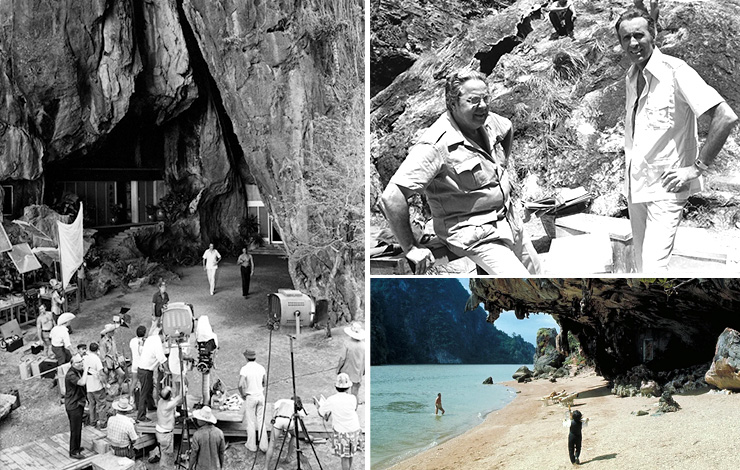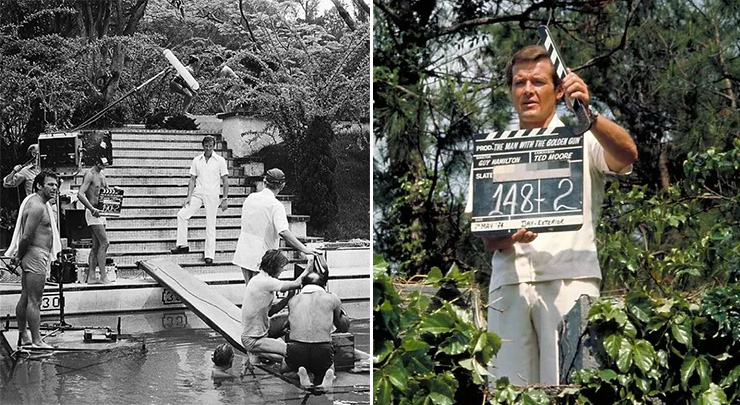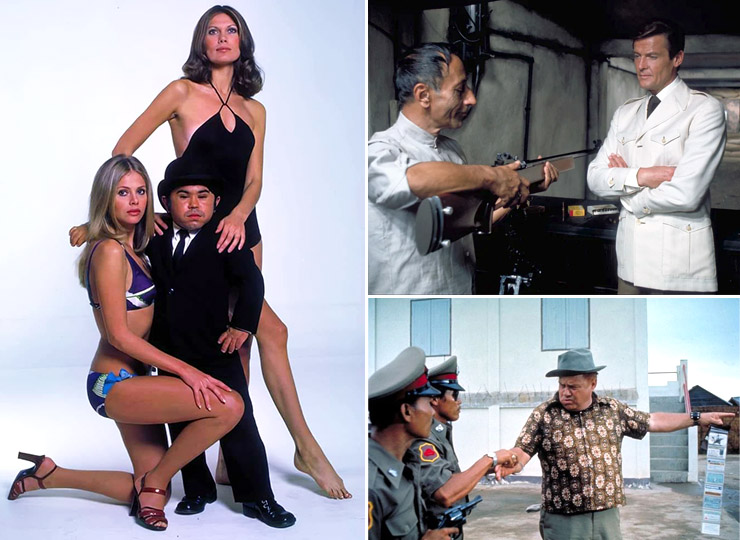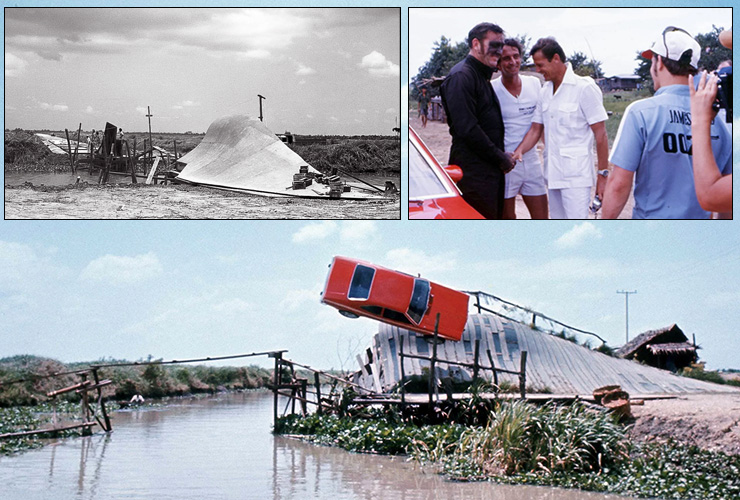|
The
Man With |
||
|
||
|
The
Man With |
||
|
||
 |
|
As the script neared completion, casting got underway in London with Alexandra Bastedo (1946-2017), who had played Meg in Casino Royale (1967), and Fiona Lewis (1946- ) [who had also appeared as one of the casino guests, car wash girls and in the gym sequence with Terence Cooper] testing for the role of Andrea. Both actresses had also appeared in the February 1967 edition of PLAYBOY as part of the ‘Girls of James Bond’ photo-spread written by Woody Allen, and photographed by Larry Shaw and Terry O’Neill. Testing for the role of MI6 officer Mary Goodnight were English actress Helen Gill, and glamour model Chekkie Maskell. The two lead roles ultimately went to Swedish actresses Maud Adams, and Britt Ekland, whose agent had pushed for the role following her appearance in the 1973 cult classic The Wicker Man alongside horror icon Christopher Lee, who was cast as Francisco Scaramanga – “The Man With The Golden Gun”. Writer Tom Mankiewicz had earlier suggested Jack Palance (1919-2006) for the role, but the American actor turned down the opportunity to become a Bond villain after a meeting in Los Angeles with director Guy Hamilton and co-producer ‘Cubby’ Broccoli. The role of Scaramanga’s diminutive manservant Nick Nack (named Demi-Tasse [Half Cup] in the original draft screenplay) went to French actor and painter Hervé Villechaize, with American actor Clifton James invited to reprise his role as Sheriff J. W. Pepper, who in The Man With The Golden Gun is incongruously holidaying in Thailand. Clifton James was asked by ‘Cubby’ Broccoli to purchase a selection of Hawaiian shirts from Macy’s department store in New York to wear on location, which the actor duly did, only to find they had been made in Bangkok! |
 |
||||||||||
|
Live And Let Die’s Production designer Syd Cain proved unavailable as he was still engaged on Gold (1974) in South Africa with ex-James Bond editor and director Peter Hunt. Roger Moore starred in the British thriller from a novel by Wilbur Smith after finishing work on Live And Let Die (1973). Ken Adam was also busy working on Barry Lyndon (1975) for director Stanley Kubrick, so Peter Murton who had been the art director on Goldfinger (1964) and Thunderball (1965) returned to the series, and was promoted to Production Designer on The Man With The Golden Gun. Ted Moore also returned as cinematographer, which was to be his seventh and final James Bond film. Whilst location scouting, Peter Murton saw the wreck of the liner Queen Elizabeth which had capsized in Hong Kong harbour in 1972 after a fire broke out when the ship was being refurbished. Producer Albert R. Broccoli came up with the idea of having M’s office on board the wreck and a small crew filmed exteriors of the liner on November 6, 1973 shortly before the Queen Elizabeth was due to be moved and scrapped. As Roger Moore was not scheduled to start work until Spring 1974 he was briefly doubled by Hong Kong resident Mike Lovatt. Ian Fleming had set the climax of his 1956 novel DIAMONDS ARE FOREVER on board the Cunard liner Queen Elizabeth, although for the 1971 big-screen version starring Sean Connery, filmmakers used the exterior of the P&O liner S.S. Canberra filmed at Southampton Docks. |
||||||||||
 |
||||||||||
|
Principal photography began on April 18, 1974 with the exteriors of Scaramanga’s hideaway on Khao Ping Kan Island. After eight days the production then moved to Hong Kong and Kowloon, with the Dragon Garden, Castle Peak doubling as Hai Fat’s estate. The streets of Hong Kong also stood in for Macau. After enduring the harsh conditions on Khao Ping Kan Island, the cast and crew stayed at the luxury Peninsula Hotel in Hong Kong, which also features in The Man With The Golden Gun (1974). On May 14, 1974 Roger Moore and Maud Adams filmed on board the Hydrofoil Flying Sandpiper, and later at the floating Casino De Macau where Bond observes the journey of Scaramanga’s golden bullets. |
||||||||||
|
||||||||||
|
Filming in Bangkok began on May 20, 1974, with the exteriors of the Thai boxing match venue, and two days later in the gardens of the Oriental Hotel for Bond’s romantic evening meal with Mary Goodnight. For three days beginning May 24, 1974, Bond’s Kung Fu fight with Chula (Chan Yiu Lam) and escape from the Martial Arts Academy were filmed, followed by the boat chase along the Thai Klongs ending with the introduction of Sheriff J. W. Pepper (Clifton James). |
||||||||||
 |
||||||||||
|
On June 1, 1974, the crew filmed the 360-degree corkscrew jump across a wrecked bridge at Klong Rangsit. Performed by Loren “Bumps” Willert [pictured below in black], the stunt became the signature image from the film, and appeared in stills and on the theatrical poster painted by Robert McGinnis – although the car illustrated resembles Scaramanga’s AMC Matador Coupe rather than Bond’s red AMC Hornet. The idea for the set-piece originated when stunt driver Joie Chitwood (who worked on Live And Let Die) sent director Guy Hamilton a photograph of a car undertaking a corkscrew jump at a US arena as part of The American Thrill Show, staged by JM Productions [Walter Jay Milligan, Jr. - stunt co-ordinator on The Man With The Golden Gun]. The ‘Astro Spiral Jump’ was then licensed by EON Productions for its appearance in The Man With The Golden Gun. Based on mathematical and computerised calculations provided by the Calspan Corporation in New York, the car had to be perfectly balanced – so the driver and steering wheel had to be positioned exactly in the middle of the car. The vehicle then had to hit a curved ramp (disguised as the broken-down bridge in the film) at exactly 48 miles per hour in order to achieve the velocity required to make the spin. Two dummies of Bond and Sheriff Pepper were positioned either side of Willert, who was dressed in black so he wouldn’t register on camera. Ultimately performed to perfection in one take, the stunt was slightly slowed down in the finished film for maximum effect, although John Barry’s inclusion of a slide-whistle on the soundtrack somewhat undermines the final result, and the composer later regretted his decision. |
||||||||||
 |
||||||||||
|
CONTINUED >> |
 |
|||||||||
|
|
||||||||||
|
||||||||||
|
|
||||||||||